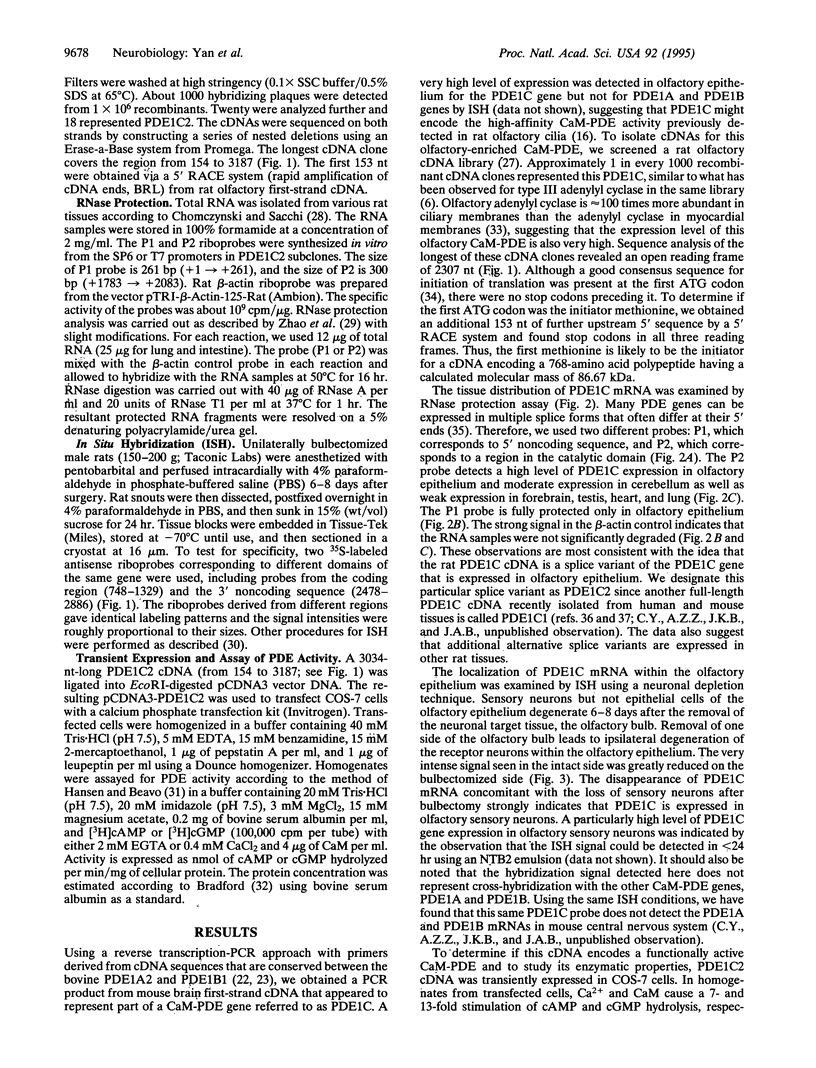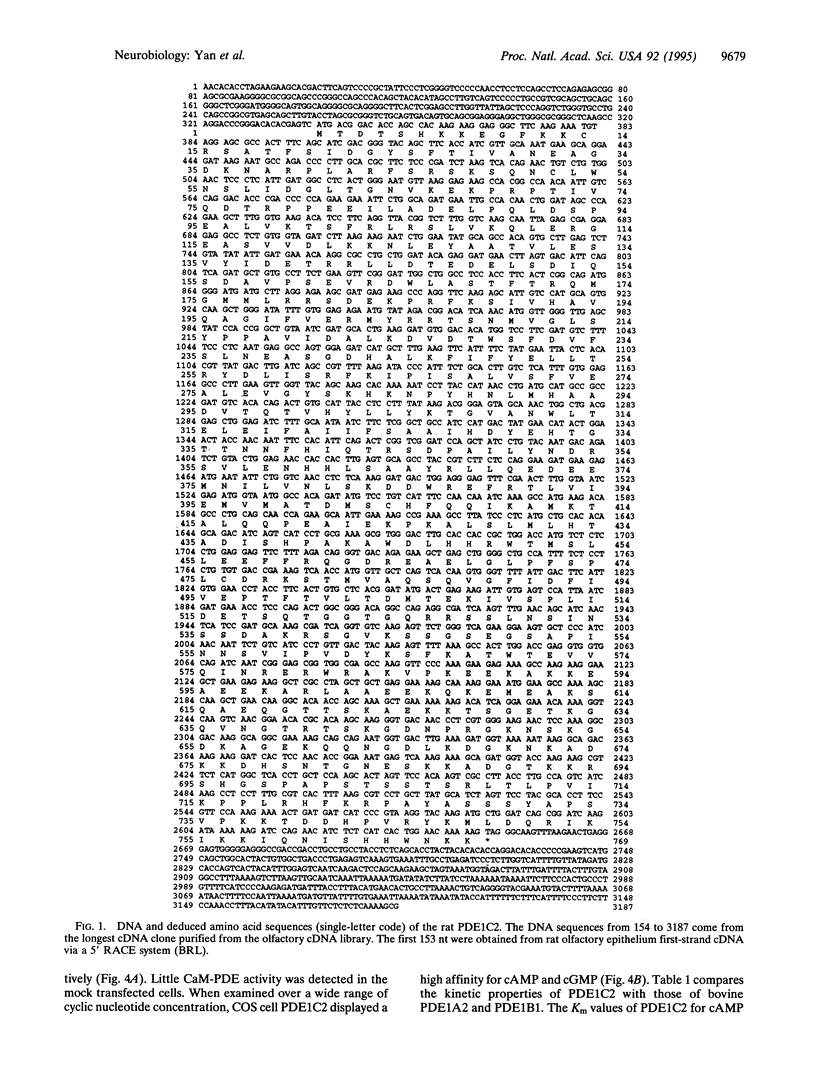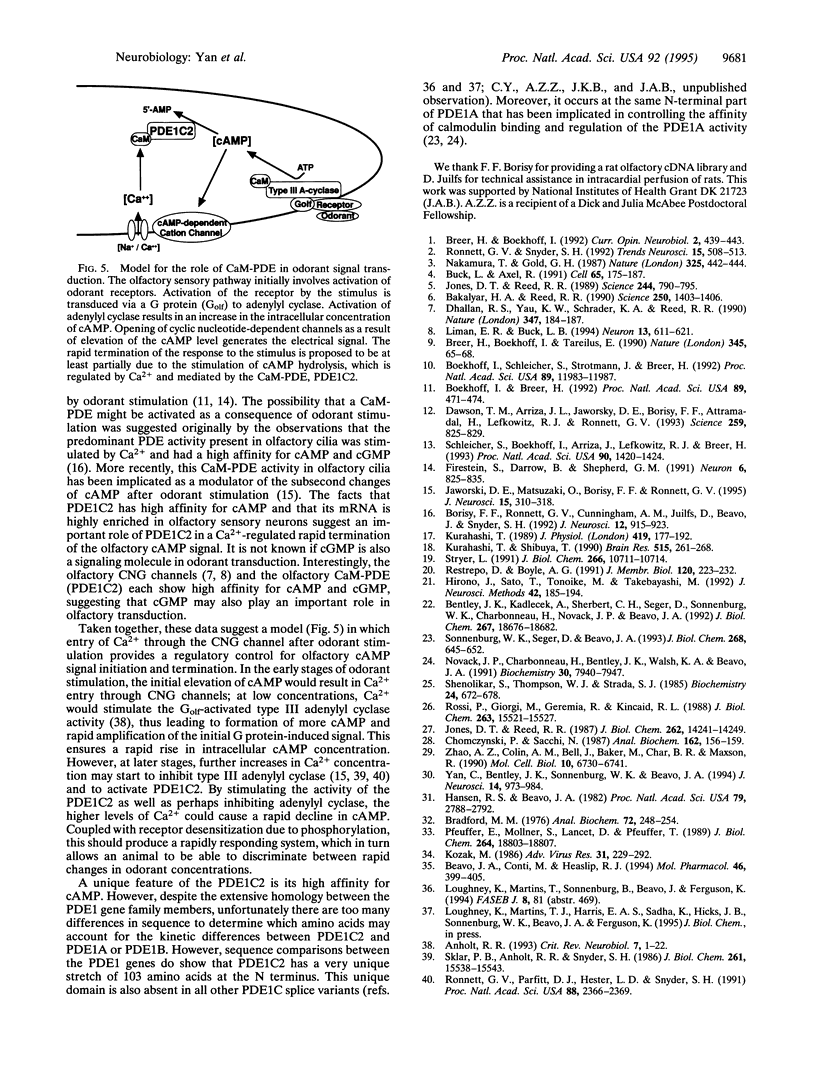Abstract
The sensing of an odorant by an animal must be a rapid but transient process, requiring an instant response and also a speedy termination of the signal. Previous biochemical and electrophysiological studies suggest that one or more phosphodiesterases (PDEs) may play an essential role in the rapid termination of the odorant-induced cAMP signal. Here we report the molecular cloning, expression, and characterization of a cDNA from rat olfactory epithelium that encodes a member of the calmodulin-dependent PDE family designated as PDE1C. This enzyme shows high affinity for cAMP and cGMP, having a Km for cAMP much lower than that of any other neuronal Ca2+/calmodulin-dependent PDE. The mRNA encoding this enzyme is highly enriched in olfactory epithelium and is not detected in six other tissues tested. However, RNase protection analyses indicate that other alternative splice variants related to this enzyme are expressed in several other tissues. Within the olfactory epithelium, this enzyme appears to be expressed exclusively in the sensory neurons. The high affinity for cAMP of this Ca2+/calmodulin-dependent PDE and the fact that its mRNA is highly concentrated in olfactory sensory neurons suggest an important role for it in a Ca(2+)-regulated olfactory signal termination.
Full text
PDF




Images in this article
Selected References
These references are in PubMed. This may not be the complete list of references from this article.
- Anholt R. R. Molecular neurobiology of olfaction. Crit Rev Neurobiol. 1993;7(1):1–22. [PubMed] [Google Scholar]
- Bakalyar H. A., Reed R. R. Identification of a specialized adenylyl cyclase that may mediate odorant detection. Science. 1990 Dec 7;250(4986):1403–1406. doi: 10.1126/science.2255909. [DOI] [PubMed] [Google Scholar]
- Beavo J. A., Conti M., Heaslip R. J. Multiple cyclic nucleotide phosphodiesterases. Mol Pharmacol. 1994 Sep;46(3):399–405. [PubMed] [Google Scholar]
- Bentley J. K., Kadlecek A., Sherbert C. H., Seger D., Sonnenburg W. K., Charbonneau H., Novack J. P., Beavo J. A. Molecular cloning of cDNA encoding a "63"-kDa calmodulin-stimulated phosphodiesterase from bovine brain. J Biol Chem. 1992 Sep 15;267(26):18676–18682. [PubMed] [Google Scholar]
- Boekhoff I., Breer H. Termination of second messenger signaling in olfaction. Proc Natl Acad Sci U S A. 1992 Jan 15;89(2):471–474. doi: 10.1073/pnas.89.2.471. [DOI] [PMC free article] [PubMed] [Google Scholar]
- Boekhoff I., Schleicher S., Strotmann J., Breer H. Odor-induced phosphorylation of olfactory cilia proteins. Proc Natl Acad Sci U S A. 1992 Dec 15;89(24):11983–11987. doi: 10.1073/pnas.89.24.11983. [DOI] [PMC free article] [PubMed] [Google Scholar]
- Borisy F. F., Ronnett G. V., Cunningham A. M., Juilfs D., Beavo J., Snyder S. H. Calcium/calmodulin-activated phosphodiesterase expressed in olfactory receptor neurons. J Neurosci. 1992 Mar;12(3):915–923. doi: 10.1523/JNEUROSCI.12-03-00915.1992. [DOI] [PMC free article] [PubMed] [Google Scholar]
- Bradford M. M. A rapid and sensitive method for the quantitation of microgram quantities of protein utilizing the principle of protein-dye binding. Anal Biochem. 1976 May 7;72:248–254. doi: 10.1016/0003-2697(76)90527-3. [DOI] [PubMed] [Google Scholar]
- Breer H., Boekhoff I. Second messenger signalling in olfaction. Curr Opin Neurobiol. 1992 Aug;2(4):439–443. doi: 10.1016/0959-4388(92)90177-m. [DOI] [PubMed] [Google Scholar]
- Breer H., Boekhoff I., Tareilus E. Rapid kinetics of second messenger formation in olfactory transduction. Nature. 1990 May 3;345(6270):65–68. doi: 10.1038/345065a0. [DOI] [PubMed] [Google Scholar]
- Buck L., Axel R. A novel multigene family may encode odorant receptors: a molecular basis for odor recognition. Cell. 1991 Apr 5;65(1):175–187. doi: 10.1016/0092-8674(91)90418-x. [DOI] [PubMed] [Google Scholar]
- Chomczynski P., Sacchi N. Single-step method of RNA isolation by acid guanidinium thiocyanate-phenol-chloroform extraction. Anal Biochem. 1987 Apr;162(1):156–159. doi: 10.1006/abio.1987.9999. [DOI] [PubMed] [Google Scholar]
- Dawson T. M., Arriza J. L., Jaworsky D. E., Borisy F. F., Attramadal H., Lefkowitz R. J., Ronnett G. V. Beta-adrenergic receptor kinase-2 and beta-arrestin-2 as mediators of odorant-induced desensitization. Science. 1993 Feb 5;259(5096):825–829. doi: 10.1126/science.8381559. [DOI] [PubMed] [Google Scholar]
- Dhallan R. S., Yau K. W., Schrader K. A., Reed R. R. Primary structure and functional expression of a cyclic nucleotide-activated channel from olfactory neurons. Nature. 1990 Sep 13;347(6289):184–187. doi: 10.1038/347184a0. [DOI] [PubMed] [Google Scholar]
- Firestein S., Darrow B., Shepherd G. M. Activation of the sensory current in salamander olfactory receptor neurons depends on a G protein-mediated cAMP second messenger system. Neuron. 1991 May;6(5):825–835. doi: 10.1016/0896-6273(91)90178-3. [DOI] [PubMed] [Google Scholar]
- Hansen R. S., Beavo J. A. Purification of two calcium/calmodulin-dependent forms of cyclic nucleotide phosphodiesterase by using conformation-specific monoclonal antibody chromatography. Proc Natl Acad Sci U S A. 1982 May;79(9):2788–2792. doi: 10.1073/pnas.79.9.2788. [DOI] [PMC free article] [PubMed] [Google Scholar]
- Hirono J., Sato T., Tonoike M., Takebayashi M. Simultaneous recording of [Ca2+]i increases in isolated olfactory receptor neurons retaining their original spatial relationship in intact tissue. J Neurosci Methods. 1992 May;42(3):185–194. doi: 10.1016/0165-0270(92)90098-x. [DOI] [PubMed] [Google Scholar]
- Jaworsky D. E., Matsuzaki O., Borisy F. F., Ronnett G. V. Calcium modulates the rapid kinetics of the odorant-induced cyclic AMP signal in rat olfactory cilia. J Neurosci. 1995 Jan;15(1 Pt 1):310–318. doi: 10.1523/JNEUROSCI.15-01-00310.1995. [DOI] [PMC free article] [PubMed] [Google Scholar]
- Jones D. T., Reed R. R. Golf: an olfactory neuron specific-G protein involved in odorant signal transduction. Science. 1989 May 19;244(4906):790–795. doi: 10.1126/science.2499043. [DOI] [PubMed] [Google Scholar]
- Jones D. T., Reed R. R. Molecular cloning of five GTP-binding protein cDNA species from rat olfactory neuroepithelium. J Biol Chem. 1987 Oct 15;262(29):14241–14249. [PubMed] [Google Scholar]
- Kozak M. Regulation of protein synthesis in virus-infected animal cells. Adv Virus Res. 1986;31:229–292. doi: 10.1016/S0065-3527(08)60265-1. [DOI] [PMC free article] [PubMed] [Google Scholar]
- Kurahashi T. Activation by odorants of cation-selective conductance in the olfactory receptor cell isolated from the newt. J Physiol. 1989 Dec;419:177–192. doi: 10.1113/jphysiol.1989.sp017868. [DOI] [PMC free article] [PubMed] [Google Scholar]
- Kurahashi T., Shibuya T. Ca2(+)-dependent adaptive properties in the solitary olfactory receptor cell of the newt. Brain Res. 1990 May 7;515(1-2):261–268. doi: 10.1016/0006-8993(90)90605-b. [DOI] [PubMed] [Google Scholar]
- Liman E. R., Buck L. B. A second subunit of the olfactory cyclic nucleotide-gated channel confers high sensitivity to cAMP. Neuron. 1994 Sep;13(3):611–621. doi: 10.1016/0896-6273(94)90029-9. [DOI] [PubMed] [Google Scholar]
- Nakamura T., Gold G. H. A cyclic nucleotide-gated conductance in olfactory receptor cilia. 1987 Jan 29-Feb 4Nature. 325(6103):442–444. doi: 10.1038/325442a0. [DOI] [PubMed] [Google Scholar]
- Novack J. P., Charbonneau H., Bentley J. K., Walsh K. A., Beavo J. A. Sequence comparison of the 63-, 61-, and 59-kDa calmodulin-dependent cyclic nucleotide phosphodiesterases. Biochemistry. 1991 Aug 13;30(32):7940–7947. doi: 10.1021/bi00246a010. [DOI] [PubMed] [Google Scholar]
- Pfeuffer E., Mollner S., Lancet D., Pfeuffer T. Olfactory adenylyl cyclase. Identification and purification of a novel enzyme form. J Biol Chem. 1989 Nov 5;264(31):18803–18807. [PubMed] [Google Scholar]
- Restrepo D., Boyle A. G. Stimulation of olfactory receptors alters regulation of [Cai] in olfactory neurons of the catfish (Ictalurus punctatus). J Membr Biol. 1991 Mar;120(3):223–232. doi: 10.1007/BF01868533. [DOI] [PubMed] [Google Scholar]
- Ronnett G. V., Parfitt D. J., Hester L. D., Snyder S. H. Odorant-sensitive adenylate cyclase: rapid, potent activation and desensitization in primary olfactory neuronal cultures. Proc Natl Acad Sci U S A. 1991 Mar 15;88(6):2366–2369. doi: 10.1073/pnas.88.6.2366. [DOI] [PMC free article] [PubMed] [Google Scholar]
- Ronnett G. V., Snyder S. H. Molecular messengers of olfaction. Trends Neurosci. 1992 Dec;15(12):508–513. doi: 10.1016/0166-2236(92)90104-g. [DOI] [PubMed] [Google Scholar]
- Rossi P., Giorgi M., Geremia R., Kincaid R. L. Testis-specific calmodulin-dependent phosphodiesterase. A distinct high affinity cAMP isoenzyme immunologically related to brain calmodulin-dependent cGMP phosphodiesterase. J Biol Chem. 1988 Oct 25;263(30):15521–15527. [PubMed] [Google Scholar]
- Schleicher S., Boekhoff I., Arriza J., Lefkowitz R. J., Breer H. A beta-adrenergic receptor kinase-like enzyme is involved in olfactory signal termination. Proc Natl Acad Sci U S A. 1993 Feb 15;90(4):1420–1424. doi: 10.1073/pnas.90.4.1420. [DOI] [PMC free article] [PubMed] [Google Scholar]
- Shenolikar S., Thompson W. J., Strada S. J. Characterization of a Ca2+-calmodulin-stimulated cyclic GMP phosphodiesterase from bovine brain. Biochemistry. 1985 Jan 29;24(3):672–678. doi: 10.1021/bi00324a020. [DOI] [PubMed] [Google Scholar]
- Sklar P. B., Anholt R. R., Snyder S. H. The odorant-sensitive adenylate cyclase of olfactory receptor cells. Differential stimulation by distinct classes of odorants. J Biol Chem. 1986 Nov 25;261(33):15538–15543. [PubMed] [Google Scholar]
- Sonnenburg W. K., Seger D., Beavo J. A. Molecular cloning of a cDNA encoding the "61-kDa" calmodulin-stimulated cyclic nucleotide phosphodiesterase. Tissue-specific expression of structurally related isoforms. J Biol Chem. 1993 Jan 5;268(1):645–652. [PubMed] [Google Scholar]
- Stryer L. Visual excitation and recovery. J Biol Chem. 1991 Jun 15;266(17):10711–10714. [PubMed] [Google Scholar]
- Yan C., Bentley J. K., Sonnenburg W. K., Beavo J. A. Differential expression of the 61 kDa and 63 kDa calmodulin-dependent phosphodiesterases in the mouse brain. J Neurosci. 1994 Mar;14(3 Pt 1):973–984. doi: 10.1523/JNEUROSCI.14-03-00973.1994. [DOI] [PMC free article] [PubMed] [Google Scholar]
- Zhao A. Z., Colin A. M., Bell J., Baker M., Char B. R., Maxson R. Activation of a late H2B histone gene in blastula-stage sea urchin embryos by an unusual enhancer element located 3' of the gene. Mol Cell Biol. 1990 Dec;10(12):6730–6741. doi: 10.1128/mcb.10.12.6730. [DOI] [PMC free article] [PubMed] [Google Scholar]




